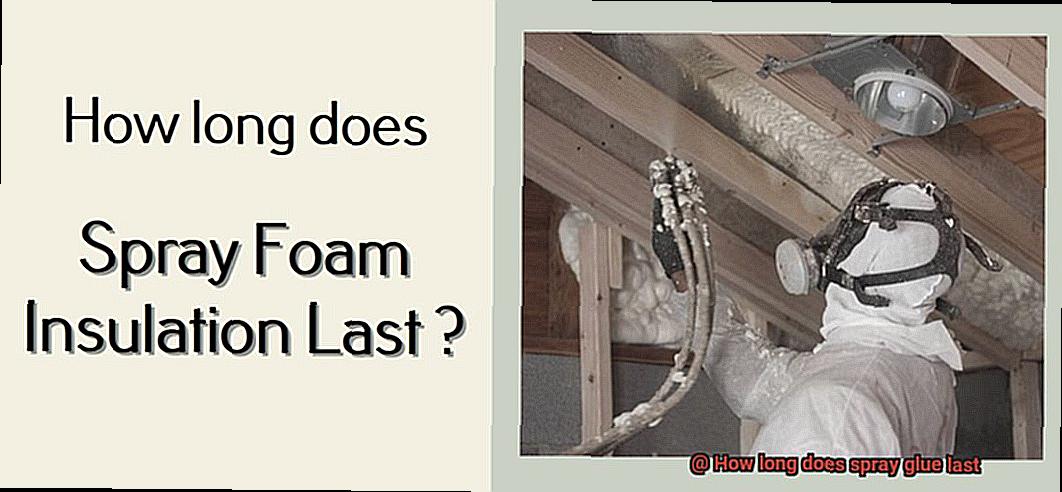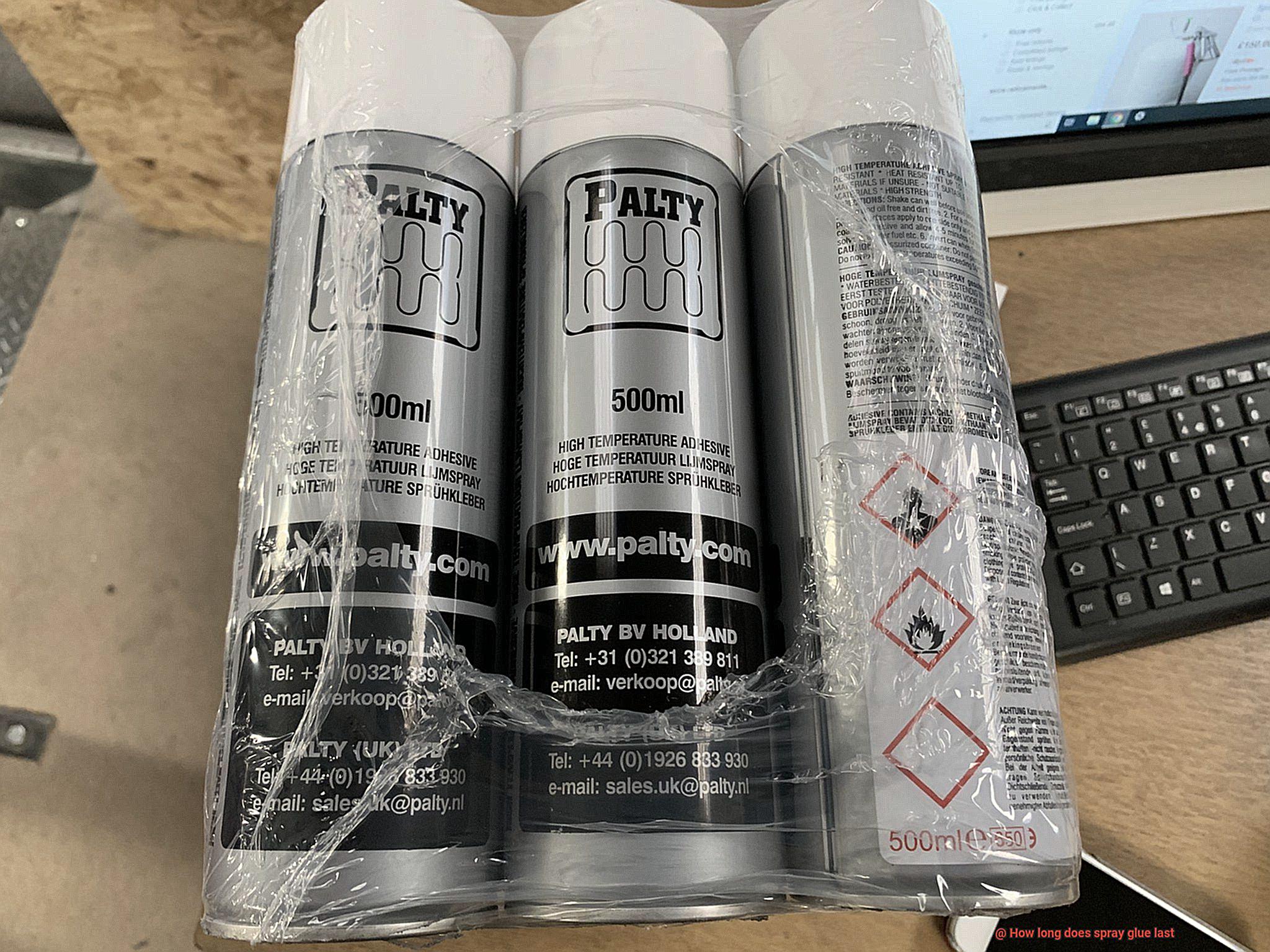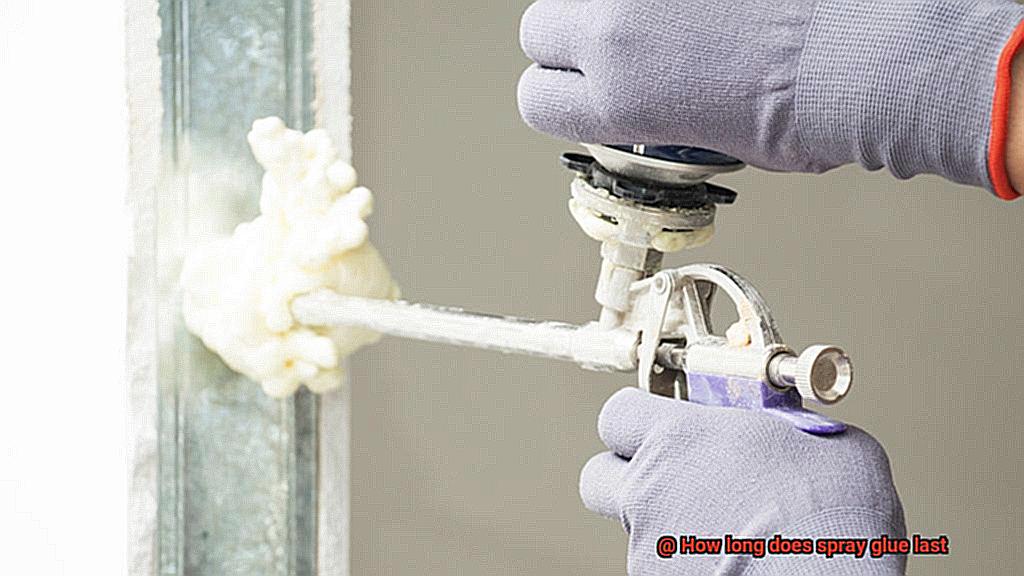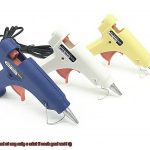Welcome, my friend.
Contents
- 1 Different types of spray glues and their characteristics
- 2 Factors that affect the longevity of spray glue
- 3 The impact of material on the durability of spray glue
- 4 Environmental conditions and their influence on spray glue’s lifespan
- 5 Importance of following manufacturer’s instructions for optimal bonding
- 6 Tips for maximizing the lifespan of spray glue
- 7 Common issues with spray glue and how to address them
- 8 Alternatives to spray glue for long-lasting adhesion
- 9 Conclusion
Are you tired of your DIY projects going kaput? Well, worry no more because I’ve got some nifty info that might just save the day.
Today, we’re diving headfirst into the world of spray glue and uncovering its staying power. Imagine this: you’ve just wrapped up a stunning craft or repair job using spray glue, and now you’re wondering, “How long will it hold?”
Fear not, for I’m here to spill the beans. In this blog post, we’ll chat about how long spray glue can go the distance and give you a crystal-clear idea of its adhesive endurance.
So strap in and let’s unveil the mysteries of spray glue’s lifespan together, shall we?
Different types of spray glues and their characteristics
Spray glues are the unsung heroes of the crafting and repair world, allowing us to effortlessly bond materials together with ease. But with a wide range of spray glues available, it can be overwhelming to choose the right one for your specific project. In this comprehensive guide, we will explore the different types of spray glues and their unique characteristics, helping you make an informed decision and achieve optimal results.
Multipurpose Spray Glue:
Versatile and reliable, multipurpose spray glue is a jack-of-all-trades adhesive that can tackle various materials like paper, fabric, foam, plastic, and lightweight wood. Its strength lies in its ability to provide a strong and durable bond that can withstand moderate stress. Whether you’re working on crafts, hobbies, or general repairs, this glue has got you covered.
High-Strength Spray Glue:
When heavy-duty bonding is required, high-strength spray glue steps up to the challenge. Formulated for superior adhesion, it excels at bonding metal, wood, or laminates. Its fast-drying formula ensures quick results while boasting excellent resistance to extreme temperatures and moisture. For demanding projects that demand strength and longevity, this glue is a go-to choice.
Foam Spray Glue:
Specifically designed for foam materials like upholstery foam or insulation panels, foam spray glue offers a flexible bond with exceptional adhesion. Its longer open time allows for repositioning before the adhesive sets, ensuring your foam projects come out perfectly aligned. Whether you’re upholstering furniture or insulating your home, foam spray glue is your secret weapon.
Fabric Spray Glue:
Bring your fabric creations to life with fabric spray glue, specially formulated to bond fabrics together or adhere fabric to other surfaces like wood or metal. This glue provides a secure bond without staining or stiffening the fabric, making it ideal for upholstery projects, costume making, and crafting. With fabric spray glue, your creations will withstand the test of time.
Repositionable Spray Glue:
For projects that demand flexibility, repositionable spray glue is the answer. This temporary adhesive allows you to move or adjust glued items until you achieve the perfect placement. Ideal for scrapbooking, stenciling, and other artistic endeavors, repositionable spray glue gives you the freedom to experiment without the fear of a permanent commitment.
Specialty Spray Glues:
In addition to the standard types, there are specialty spray glues designed for specific applications. These include adhesive sprays for mounting photos or artwork, automotive trim adhesive sprays, and even food-safe spray glues for culinary projects. These specialized glues cater to niche needs and offer unique properties tailored to their respective applications.
Factors that affect the longevity of spray glue
Spray glue, the unsung hero of crafting and repair, has the power to revolutionize the way materials bond together. But how can we ensure that the bond created by spray glue will endure the test of time? Let’s explore the factors that influence the longevity of spray glue and discover how we can optimize them for maximum bond strength and durability.
First and foremost, the quality of the glue itself is of paramount importance. High-quality adhesives are meticulously formulated to provide a robust and long-lasting bond. They are specifically designed to withstand various environmental conditions, such as fluctuating temperatures, humidity, and even exposure to harmful UV light. Investing in a reputable brand that offers superior quality is essential if you want your bonds to stand strong against the ravages of time.
Surface preparation is another critical factor in creating a lasting bond with spray glue. Just as in any relationship, a good bond begins with a clean slate. It is imperative to ensure that the surface you intend to bond is meticulously cleaned, thoroughly dried, and completely free from any dirt, dust, or grease. Any contaminants present on the surface can impede the adhesive’s ability to adhere effectively, resulting in a weaker bond that may not hold up over time.
When it comes to application technique, following the manufacturer’s instructions diligently is key. This includes adhering to the recommended distance between the nozzle and the surface, as well as ensuring an even application throughout. Applying too much or too little glue can significantly impact the strength and durability of the bond. So take your time and carefully follow these instructions to achieve optimal outcomes.

Substrate compatibility is yet another crucial factor influencing the longevity of spray glue bonds. Different spray glues are explicitly engineered for specific materials or substrates. Using a spray glue that is not compatible with the substrate can lead to a weaker bond that may deteriorate over time. To ensure long-lasting bonds, it is imperative to choose a glue that is specifically designed for the materials you are working with.
Environmental conditions also play a significant role in the durability of spray glue bonds. Extreme temperatures can cause the adhesive to expand or contract, ultimately affecting its bond strength. Similarly, high humidity levels can weaken the adhesive, while exposure to UV light can gradually degrade certain types of glues. To combat these challenges, it is essential to consider these factors and select an adhesive that is suitable for the intended environment.
Finally, proper storage is crucial for maintaining the effectiveness and longevity of spray glue. It is imperative to store adhesive products in a cool, dry place, away from direct sunlight or extreme temperatures. Heat and moisture can deteriorate the glue over time, resulting in a shorter shelf life and reduced bonding strength.
The impact of material on the durability of spray glue
The durability of spray glue is undeniably affected by the material being bonded. Each material possesses unique properties that can either enhance or hinder the strength and longevity of adhesive bonds. Let’s embark on a captivating exploration of how different materials impact the durability of spray glue, uncovering the secrets behind a bond that stands the test of time.
Porosity, the presence of tiny holes or gaps, is a crucial factor to consider. Materials like paper and fabric are inherently porous, allowing them to absorb more glue. This absorption creates a powerful bond as the adhesive seeps into every crevice, forging a tight grip that refuses to let go. So, whether you’re indulging in intricate paper crafts or upholstering luxurious fabrics, rest assured that spray glue will rise to the occasion, providing adhesion that endures for years to come.
However, smooth surfaces like glass or metal present a formidable challenge for spray glue. The lack of pores or roughness renders it difficult for the adhesive to cling effectively. In such cases, it becomes imperative to either select a stronger adhesive capable of conquering these slippery obstacles or venture into the realm of surface preparation. By gently roughening up the smooth surface, creating texture for the glue to latch onto, you pave the way for a bond that defies all odds.
Flexibility also plays a pivotal role in the durability of spray glue. Imagine attempting to affix a rigid adhesive onto a rubberized surface – with each bend and stretch, your bond would crack and crumble beneath the strain. Thus, it becomes paramount to choose an adhesive specifically formulated for flexible materials, one that possesses the resilience necessary to withstand movement without sacrificing its unwavering grip. By embracing this harmony between flexibility and adhesive strength, you ensure that your bond remains unyielding even in the face of constant motion.
Let us not overlook the plight of heat-sensitive materials. Certain plastics tremble at the touch of high temperatures, their delicate structures vulnerable to irreversible damage. To safeguard against such a perilous fate, it is crucial to employ a low-temperature adhesive that delicately cradles these materials during the bonding process. By honoring the compatibility between your chosen spray glue and the material at hand, you forge a bond that transcends mere effectiveness, emerging as a testament to longevity and resilience.
Surface preparation, the sacred ritual that precedes the application of spray glue, holds the key to durability. Before embarking on this adhesive journey, ensure that the surface is cleansed thoroughly, purged of any dirt, oils, or debris that could sabotage the glue’s efficacy. And if the need arises, do not shy away from roughening the terrain ever so slightly with sandpaper or a kindred spirit – this gentle rebellion creates a better surface for the glue to embrace, fortifying the bond and leaving no room for doubt.
Environmental conditions and their influence on spray glue’s lifespan
The lifespan of spray glue is influenced by a variety of environmental conditions. Temperature, humidity, storage conditions, fluctuations in environmental conditions, and impurities in the air all play a role in determining how long a spray glue will remain effective.
Let’s start with temperature. Just like humans, spray glue has a preferred temperature range for optimal performance. High temperatures can cause the glue to dry out quickly, leading to a shorter lifespan. On the other hand, extremely low temperatures can make the glue brittle and less effective. So it’s important to use spray glue within the recommended temperature range specified by the manufacturer.
Humidity levels also have a significant impact on the lifespan of spray glue. Excessive moisture in the air can hinder the adhesive’s ability to bond properly, while extremely dry conditions may cause the glue to cure too fast, resulting in weaker adhesion. Finding the right balance, like Goldilocks’ porridge, is key – not too wet and not too dry.
Storage conditions are equally important. To maintain the quality of spray glue and extend its lifespan, it should be stored in a cool and dry place. Exposure to direct sunlight should be avoided as it can accelerate the degradation of the adhesive. Imagine leaving your favorite ice cream out in the sun – it melts away, losing its sweetness and becoming a sticky mess.
Fluctuations in environmental conditions can also have an adverse impact on the lifespan of spray glue. If a glued surface is constantly exposed to varying temperatures or humidity levels, it may weaken the bond over time. Think of it like stretching a rubber band back and forth – eventually, it loses its elasticity and breaks.
But that’s not all. Impurities in the air such as pollution, dust, and contaminants can also affect the lifespan of spray glue. These impurities may interfere with the adhesive’s ability to bond properly and reduce its overall effectiveness. It’s like trying to stick two pieces of paper together, but there’s a layer of dirt in between – the bond won’t be as strong.
To ensure the longest lifespan possible for your spray glue, it’s important to assess and control the environmental conditions in which it is used. This may involve working in a well-ventilated area with moderate temperature and humidity levels. Remember, the longevity of your adhesive bond is not just about the glue itself, but also about the environment in which it exists.
Importance of following manufacturer’s instructions for optimal bonding
If you’ve ever found yourself in a sticky situation (pun intended) where spray glue was your knight in shining armor, then listen up. Following the manufacturer’s instructions is the secret to unlocking the full potential of optimal bonding. Believe me, it’s a game-changer.

Why is it so crucial, you ask? Welcome to the captivating world of spray glue, where we uncover the mysteries behind achieving that perfect bond that stands the test of time.
Mastering Application Techniques and Drying Times:
Every type of spray glue has its own unique personality. From specific application temperatures to recommended humidity levels, the manufacturer’s instructions hold the key to success. By heeding these guidelines, you ensure that your glue performs at its absolute best, guaranteeing a bond that lasts.
Surfaces: Friends or Foes?
Not all materials are created equal when it comes to bonding with spray glue. Fear not. The manufacturer’s instructions act as your trusty guide, enlightening you on which surfaces are compatible with your adhesive dreams. Say goodbye to mishaps and potential damage to your beloved projects. Stick to the instructions, my friend.
Safety First, Always:
Let’s talk about those sneaky volatile organic compounds (VOCs) lurking in spray glues. Inhaling or misusing them can be harmful. Thankfully, the manufacturer’s instructions provide essential safety precautions such as proper ventilation and personal protective equipment. Protect yourself by following these guidelines because safety should never be compromised.
Unlocking Pro-Level Tips and Tricks:
Ever wondered how the pros achieve those flawless bonds? Well, guess what? The manufacturer’s instructions often contain hidden gems of wisdom. From applying multiple coats to allowing ample drying time or using additional techniques like pressing or clamping surfaces together, these secrets can elevate your bonding game to new heights.
The Price of Deviation:
Deviate from the manufacturer’s instructions, and brace yourself for suboptimal results. Weak bonds that crumble like a house of cards or adhesive failure over time become real possibilities. But wait, there’s more. You also risk voiding any warranties or guarantees provided by the manufacturer. Don’t let that happen. Stick to the instructions, my friend.
In a nutshell, following the manufacturer’s instructions for optimal bonding with spray glue is the key to achieving a bond that is not just strong but also long-lasting. It’s like following a recipe for success, ensuring that your projects stick together beautifully. So, next time you reach for that can of spray glue, take a moment to read those instructions carefully and create the perfect environment for your glue to work its magic.
Tips for maximizing the lifespan of spray glue
Spray glue is a versatile adhesive that can be used for various projects. Whether you’re working on crafts, upholstery, or repairs, maximizing the lifespan of your spray glue is essential for long-lasting results. In this article, we’ll explore expert tips and tricks to help you get the most out of your spray glue.
Store in a Cool and Dry Place:
Proper storage is key to maintaining the effectiveness of your spray glue. Store it in a cool and dry spot, away from direct sunlight or extreme temperatures. This prevents the glue from drying out or losing its adhesive properties over time.
Seal the Container Properly:
After each use, make sure to tightly seal the container. This prevents air from entering and drying out the glue. Look for a built-in nozzle cap or use a separate sealing cap or cover to keep your spray glue fresh and ready for future use.
Clean the Nozzle After Each Use:
A clogged nozzle can be frustrating and affect the performance of your spray glue. To prevent this, clean the nozzle after each use by wiping off any excess glue with a clean cloth or paper towel. This simple step ensures that the nozzle remains clear and ready for your next project.
Shake Well Before Use:
Before using your spray glue, give it a good shake to mix the adhesive components thoroughly. This ensures that the glue is evenly distributed and ready to provide optimal bonding strength. A well-mixed spray glue enhances its effectiveness and longevity.
Use in a Well-Ventilated Area:
When working with spray glues, prioritize safety by using them in well-ventilated areas. These adhesives contain volatile chemicals that can be harmful if excessively inhaled. Open windows or use fans to promote proper air circulation, reducing health risks and maximizing the lifespan of your spray glue.
Common issues with spray glue and how to address them
Spray glue, the versatile adhesive that brings dreams to life, can sometimes present its fair share of challenges. Uneven application, over-saturation, clogged nozzles, strong odors, and the inability to easily reposition glued surfaces are just some of the common issues that can leave even the most skilled craftsmen scratching their heads. But worry not. In this blog post, we’ll dive into these problems and equip you with practical solutions that will turn your frustrations into triumphs.
Uneven Application: The Secret to Seamless Bonding
To achieve a flawless bond, start by purifying the surface with meticulous care. Rid it of any pesky dust or debris that dare stand in the way of perfection. Then, hold the can at a steady distance, maintaining your position like a seasoned archer. With graceful sweeps, disperse the adhesive across the surface, ensuring an even distribution that guarantees impeccable adhesion.
Over-saturation: The Art of Subtle Layers
Ah, the delicate dance between just enough and too much. Avoid drenching your surface with adhesive by applying thin layers instead. Allow each layer to dry completely before proceeding with the next step. This bewitching technique prevents excessive wetness, shorter drying times, and strengthens that bond to withstand the test of time. Remember, my friend, patience is indeed a virtue.
Clogged Nozzle: A Clean Conduit for Creativity
The nozzle, oh dear nozzle, how it loves to misbehave. Fear not, for there is a remedy to its stubborn ways. After each use, gently wipe away any remnants of adhesive clinging to its edges. If the clog persists like an unwelcome guest at a royal banquet, immerse the nozzle in warm soapy water and witness as it dissolves that stubborn residue. A clean nozzle ensures a smooth, uninterrupted flow of liquid gold.
Venture into the mysterious realm of spray glue, where strong odors lurk in the shadows. Brave souls, take heed. Seek refuge in well-ventilated sanctuaries, where the air dances with the sweet scent of freedom. Don a mask, a guardian angel protecting your delicate lungs from the potent fumes. And if you truly wish to tread lightly on this fragrant path, consider embracing low-odor or odorless spray glues that will transform your experience from cacophony to symphony.
Alternatives to spray glue for long-lasting adhesion
Spray glue – a convenient adhesive solution for many projects, but not without its challenges. From clogged nozzles to messy overspray, it can leave you feeling sticky and frustrated. But fear not. I’m here to introduce you to some fantastic alternatives that provide long-lasting adhesion without the hassle.
Let’s begin with double-sided adhesive tape – a versatile tape available in various widths and thicknesses. Whether you’re working on a crafting project or bonding materials in an industrial setting, this tape offers a clean and efficient solution. No more worries about overspray or sticky residue – simply apply the tape and enjoy a strong bond.
If you prefer the precision of liquid adhesives, options abound. Epoxy, super glue, and wood glue are just a few examples that offer strong bonds and durability. Applying these adhesives directly onto the surface or material being bonded allows for more control and accuracy than spray glue.
For those prioritizing eco-friendliness, water-based adhesives are a safe choice. Non-toxic and emitting no harmful fumes, they provide reliable bonds suitable for various surfaces and materials. Your conscience will be as clear as your adhesive.
Mechanical fasteners may be the way to go for heavier or load-bearing applications. Screws, nails, or staples offer a secure bond that can’t be beat. While they require additional tools and installation time, you’ll have peace of mind knowing your materials are securely connected.
Looking for something truly unique? Consider heat-activated adhesives. Applied in solid form, they require heat to activate the bonding process. Once heated, the adhesive melts and creates a strong, long-lasting bond. Woodworking and fabric bonding enthusiasts often rely on this reliable solution.
And finally, for temporary or removable bonds, adhesive putty or removable adhesive strips are ideal. Adhesive putty is perfect for hanging lightweight objects on walls, while removable adhesive strips are great for mounting posters or decorations. Reposition or remove them easily without damaging surfaces or materials.
d-eXYI4veWI” >
Conclusion
Spray glue, like any adhesive, has a shelf life. How long it lasts depends on various factors such as the type of glue, storage conditions, and usage. On average, spray glues can last anywhere from one to three years. However, it’s important to note that this is just an estimate and not a guarantee.
The longevity of spray glue can be influenced by its composition. Some glues are made with stronger chemical formulas that can withstand the test of time better than others. Additionally, how the glue is stored plays a crucial role in its lifespan. Keeping it in a cool, dry place away from direct sunlight and extreme temperatures can help preserve its effectiveness for longer.
Of course, how often and how intensively you use the spray glue also affects its durability. If you only use a small amount occasionally, it may last longer than if you frequently rely on it for heavy-duty projects.
To ensure that your spray glue remains effective for as long as possible, it’s recommended to check the expiration date before purchasing or using it. Additionally, pay attention to any changes in consistency or smell that might indicate degradation.
In conclusion, while there is no definitive answer to how long spray glue lasts, taking proper care of it and following storage guidelines can help extend its lifespan.






